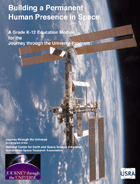 Building a Permanent Human Presence in Space is one of several Education Modules developed for the Journey through the Universe program. Building a Permanent Human Presence in Space is one of several Education Modules developed for the Journey through the Universe program.
The United States and its partners around the world are building an International Space Station (ISS), arguably the most sophisticated engineering project ever undertaken. ISS will provide a permanent human presence in low Earth orbit. The scientific motivation for developing ISS derives from the extreme nature of the space environment relative to what we experience here on Earth. ISS provides researchers long-term access to space, with its extreme temperature variation; near vacuum conditions; pervasive high-energy radiation; and free-fall conditions that produce the experience of ‘weightlessness’. If humans are to extend their presence beyond Earth, these challenges to life in space must be overcome, and ISS provides a laboratory for such research.
Substantial national investment in ISS is grounded in a broad set of needs to explore beyond the confines of our own home. Motivations for why we explore are as old as the human race, and should be studied if students are truly going to understand what drives exploration on every frontier of human activity. Motivation, however, is not enough for ISS to be realized. How we build a permanent human presence in space requires significant engineering ‘know-how’ to both lift payloads into orbit and build space habitats. Therefore the storyline approach adopted for this Module is to address three questions at each grade level: - What is the space environment like?
- Why do people want to go into space?
- How will we build a place to live in space?
Each grade-level Education Unit has a lesson addressing each of these questions. The Module contains activities at three grade levels (K-4, 5-8, 9-12). Each grade level package is called an Education Unit. The Module also includes one Family and Home activity, and one activity on the Process of Science. Both are suitable for use at all grade levels. |
Below are PDF files providing the storyline, lesson descriptions, and linkages to national standards for the Building a Human Presence Modules’ three grade-level Units. Building a Human Presence Grade K-4 Education Unit (PDF, 268 KB) Building a Human Presence Grade 5-8 Education Unit (PDF, 272 KB) Building a Human Presence Grade 9-12 Education Unit (PDF, 276 KB) |
Grade K-4 Unit, Lesson 1: There’s More to Light than Meets the Eye (PDF, 944 KB)
Students will explore the concept that not all light is visible to the human eye. Although UV light is not visible, it can still be harmful, causing sunburns or skin cancer. Students will use special beads to detect UV light around the school. They will then conduct an experiment to determine what types of materials are best for blocking UV light on Earth, as well as in space.
Grade 5-8 Unit, Lesson 1: Weightlessness (PDF, 740 KB)
There is no lack of gravity in space. In fact, it is gravity that keeps the Space Shuttle in orbit around the Earth. In essence, the Space Shuttle is falling around the Earth. Why then do astronauts have the feeling and appearance of weightlessness? In this lesson, students will create models of an astronaut and the Space Shuttle to investigate why a falling astronaut feels like he or she is weightless.
Grade 5-8 Unit, Lesson 2: Are You An Explorer? (PDF, 700 KB)
When you hear the word ‘explorer', what comes to mind? You will likely conjure up visions of noble, courageous men or women, physically battling with nature to achieve some challenging goal against grave personal risk. That isn’t the only way to explore, however. People explore the world every day, in many ways, without necessarily traveling to far off lands to do so. In this lesson, students examine the characteristics of explorers. They then create an exploration log to determine whether they too possess these qualities and are also explorers. Grade 9-12 Unit, Lesson 3: Building Your Space Station (PDF, 916 KB)
The International Space Station is arguably the greatest engineering undertaking of our time. Thousands of criteria had to be considered in the design of each station segment and in planning the final assembly. One of the most powerful design tools used by engineers in developing the station design is scale modeling, allowing engineers to test ideas for station construction by actually building the station themselves, in workshops on Earth, many times over. In this lesson, students will directly experience the station design process by using scale modeling to design and test space stations of their own. Students will be provided with a broad set of performance demands and will explore how much variation these criteria permit in the design of a complete station. Students will also develop an understanding of some of the limitations of scale modeling as a design tool. |
